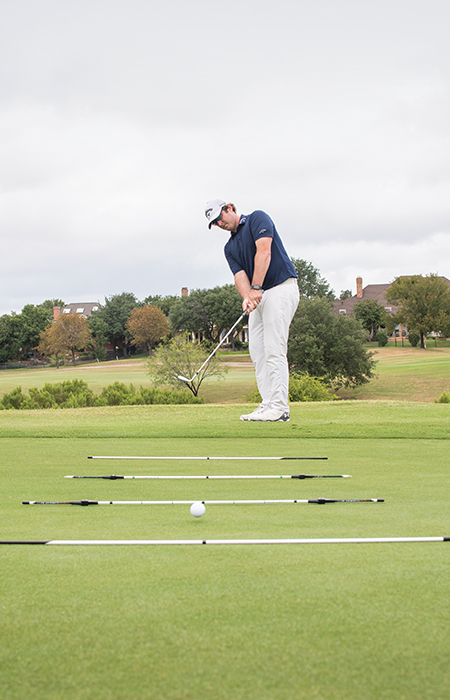Well, it’s 2020 and that time of year where new-year resolutions are still fresh in our minds. Soon enough, those new-year resolutions will slip our minds as our busy lives consume them. But this is not just a new year, it’s a new decade! Let’s kick this decade off right with a putting speed drill that I want you to incorporate into your practice as a regular part. If you want to have less 3-putts, you should be walking out the door already!

Equipment:
- 5 Balls
- 3 Tees (here I am using one tee and my Alignment Pro’s)
- Putter
The Set Up:
- Find a relatively straight, uphill putt
- Place a tee in the ground as the starting point
- Step off 3-yards in the uphill direction and place a tee (or Alignment Pro with hinges). This is the start of the zone where your balls must finish.
- Step off 2-yards and place the final tee (or Alignment Pro). This is the end of the zone.
How to Play:
- You will putt all 5 balls from the starting point
- Each ball must finish inside the zone
- Also, each ball must pass the previous ball
- If you miss the zone or get your putts out of order you must start over
- If you finish within the allotted time (15-20 minutes) take the starting point and move it 1-yard further away from the zone

Matching Line and Speed!
When it comes to making breaking putts there is an important concept we must first understand. That being “Matching line and speed”. Let’s start by discussing a straight putt. Not much to say here. It’s straight. Get it online with enough speed to get to the hole and not too much speed that it will hit the hole and not go it. There is “one line”. But, on a breaking putt, it’s a different story. There is more than one line and the correct line depends on the speed you hit your putt. A slower speed putt requires allowance for a greater amount of break than a faster speed putt. The slower it is travelling the more time gravity has to do what it does and pull the ball downhill.
As a general rule if a putt misses the hole a good holing speed would see the ball finish 12-18 inches past the cup. This gives the ball the greatest chance of going in if we consider:
- A ball that finishes at the hole is the slowest travelling putt and most susceptible to deviation by imperfections in the green.
- A ball that finishes greater than 18 inches past the hole has the most speed and if it catches the lip of the hole it has a high probability of lipping out.
Now, there are times where you might get the inclination to either “take some break out” or “die it in”. Those are situations and circumstances that you have likely encountered or will encounter at some point in time. So that you don’t dribble it by the low side or power past the high side, remember to “Match your line and speed”!